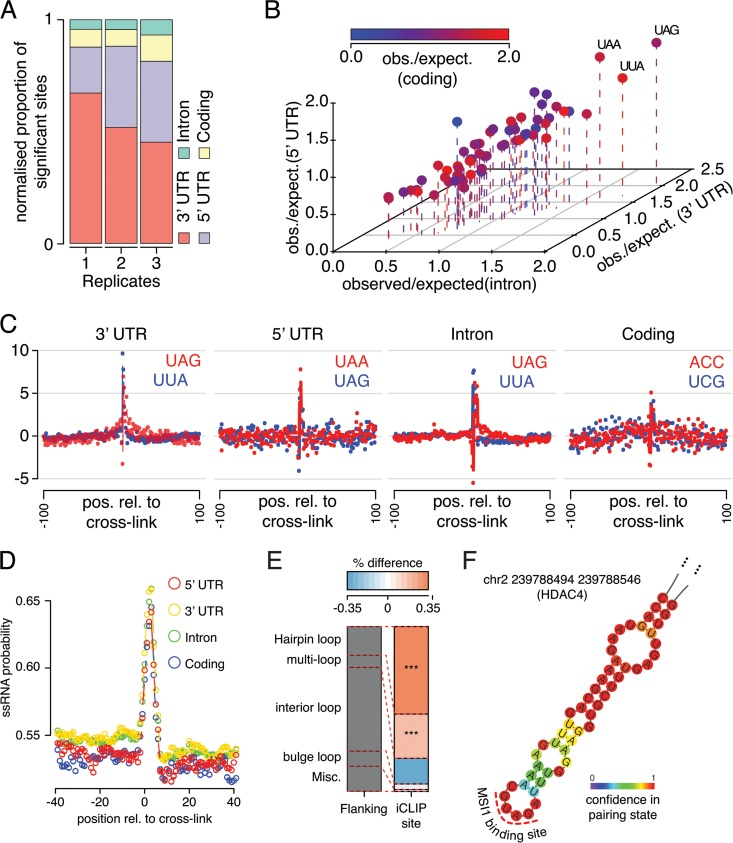RNA-Binding Protein Musashi1 Is a Central Regulator of Adhesion Pathways in Glioblastoma.
The conserved RNA-binding protein Musashi1 (MSI1) has emerged as a key oncogenic factor in numerous solid tumors, including glioblastoma. However, its mechanism of action has not yet been established comprehensively. To identify its target genes comprehensively and determine the main routes by which it influences glioblastoma phenotypes, we conducted individual-nucleotide resolution cross-linking and immunoprecipitation (iCLIP) experiments. We confirmed that MSI1 has a preference for UAG sequences contained in a particular structural context, especially in 3' untranslated regions. Although numerous binding sites were also identified in intronic sequences, our RNA transcriptome sequencing analysis does not favor the idea that MSI1 is a major regulator of splicing in glioblastoma cells. MSI1 target mRNAs encode proteins that function in multiple pathways of cell proliferation and cell adhesion. Since these associations indicate potentially new roles for MSI1, we investigated its impact on glioblastoma cell adhesion, morphology, migration, and invasion. These processes are known to underpin the spread and relapse of glioblastoma, in contrast to other tumors where metastasis is the main driver of recurrence and progression.
Authors
Philip J Uren; Dat T Vo; Patricia Rosa de Araujo; Rebecca Pötschke; Suzanne C Burns; Emad Bahrami-Samani; Mei Qiao; Raquel de Sousa Abreu; Helder I Nakaya; Bruna R Correa; Caspar Kühnöl; Jernej Ule; Jennifer L Martindale; Kotb Abdelmohsen; Myriam Gorospe; Andrew D Smith; Luiz O F Penalva
External link
Publication Year
Publication Journal
Associeted Project
Integrative Biology
Lista de serviços
-
StructRNAfinder: an automated pipeline and web server for RNA families prediction.StructRNAfinder: an automated pipeline and web server for RNA families prediction.
-
CEMiTool: a Bioconductor package for performing comprehensive modular co-expression analyses.CEMiTool: a Bioconductor package for performing comprehensive modular co-expression analyses.
-
webCEMiTool: Co-expression Modular Analysis Made Easy.webCEMiTool: Co-expression Modular Analysis Made Easy.
-
Assessing the Impact of Sample Heterogeneity on Transcriptome Analysis of Human Diseases Using MDP Webtool.Assessing the Impact of Sample Heterogeneity on Transcriptome Analysis of Human Diseases Using MDP Webtool.
-
Predicting RNA Families in Nucleotide Sequences Using StructRNAfinder.Predicting RNA Families in Nucleotide Sequences Using StructRNAfinder.
-
OUTBREAK: a user-friendly georeferencing online tool for disease surveillance.OUTBREAK: a user-friendly georeferencing online tool for disease surveillance.
-
Noninvasive prenatal paternity determination using microhaplotypes: a pilot study.Noninvasive prenatal paternity determination using microhaplotypes: a pilot study.
-
Editorial: User-Friendly Tools Applied to Genetics or Systems Biology.Editorial: User-Friendly Tools Applied to Genetics or Systems Biology.
-
Automatic detection of the parasite Trypanosoma cruzi in blood smears using a machine learning approach applied to mobile phone imagesAutomatic detection of the parasite Trypanosoma cruzi in blood smears using a machine learning approach applied to mobile phone images
-
Tucuxi-BLAST: Enabling fast and accurate record linkage of large-scale health-related administrative databases through a DNA-encoded approachTucuxi-BLAST: Enabling fast and accurate record linkage of large-scale health-related administrative databases through a DNA-encoded approach
-
Ten quick tips for harnessing the power of ChatGPT in computational biologyTen quick tips for harnessing the power of ChatGPT in computational biology

